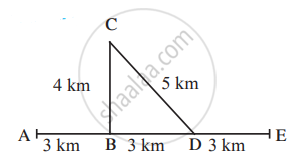Advertisements
Advertisements
प्रश्न
Exercise Problems.
A ball is gently dropped from a height of 20 m. If its velocity increases uniformly at the rate of 10 ms–2, with what velocity will it strike the ground? After what time will it strike the ground?
उत्तर
Given: height = 20 m
acceleration = 10 ms– 2
Formula: For free falling body,
- v = gt
- s = 1/2 gt2
Solution:
time taken to strike the ground
s = 1/2 gt2
20m = 1/2 × 10 ms – 2 × t2
t2 = `"40m"/"10ms"^(−2)`= 4s 2
∴ t = 2s - Velocity of the ball when it strikes ground v = gt
v = 10ms– 2 × 2s
v = 20ms– 1
APPEARS IN
संबंधित प्रश्न
The S.I. unit of velocity is ___________
Observe the figure and answer the questions.

Sachin and Sameer started on a motorbike from place A, took the turn at B, did a task at C, travelled by the route CD to D and then went on to E. Altogether, they took one hour for this journey.
Find out the actual distance traversed by them and the displacement from A to E. From this, deduce their speed.
What was their velocity from A to E in the direction AE?
Can this velocity be called average velocity?
The graph shows how the velocity of a scooter varies with time in 50 s. Interpret the graph.
A train travels from A to station B with a velocity of 100 km/h and returns from station B to station A with a velocity of 80 km/h. Its average velocity during the whole journey is ______ and its average speed is ______.
A body moves with an initial velocity of 5ms-1 and accelerates at 2ms -2. Its velocity after 10s is ______.
Assertion: A body can have acceleration even if its velocity is zero at a given instant of time.
Reason: A body is momentarily at rest when it reverses its direction of motion.
Define velocity.
Define velocity.
Define velocity.
Define velocity.
